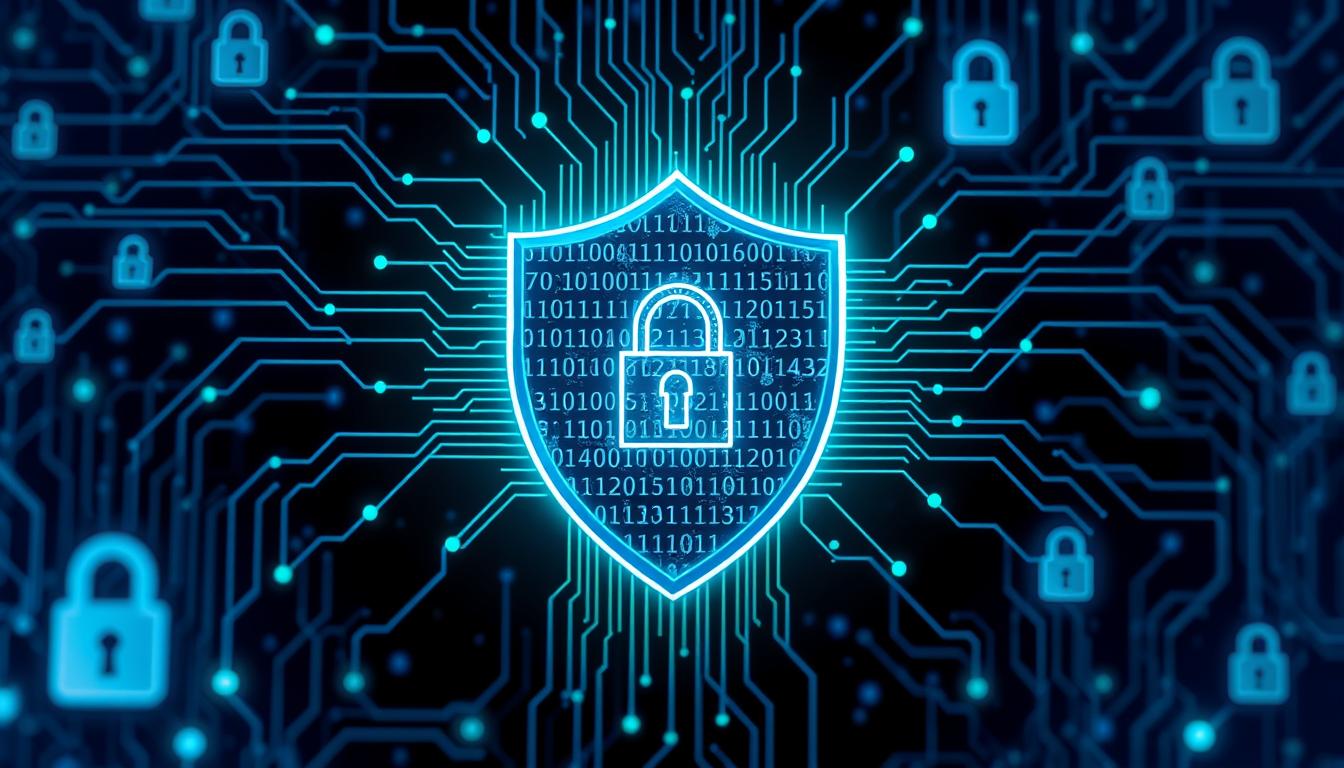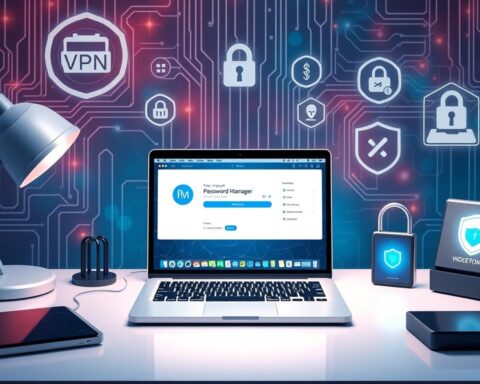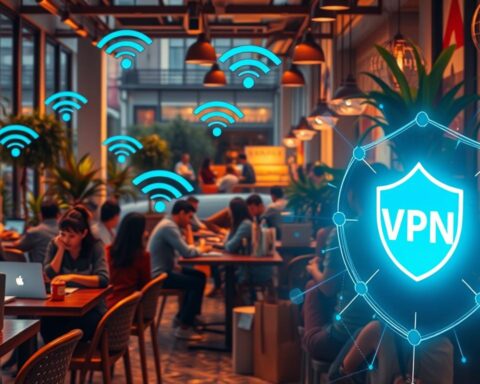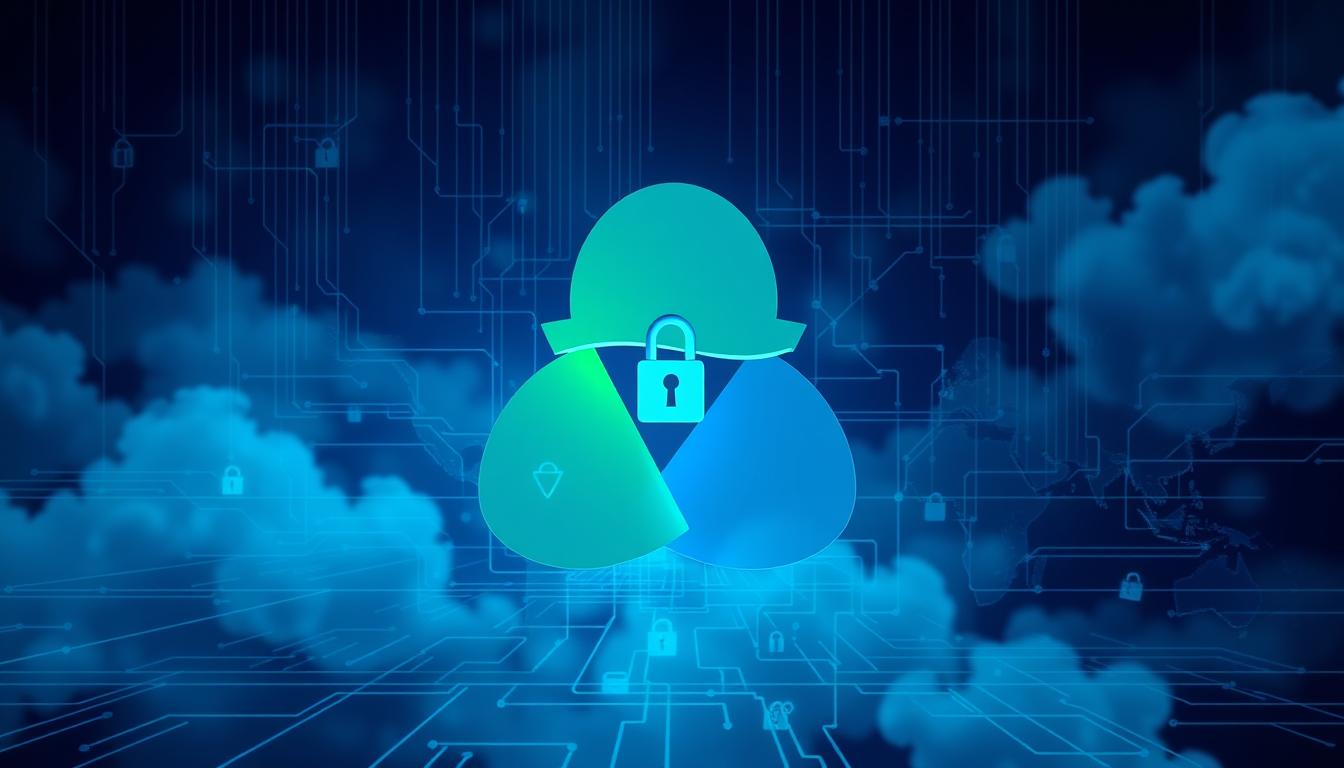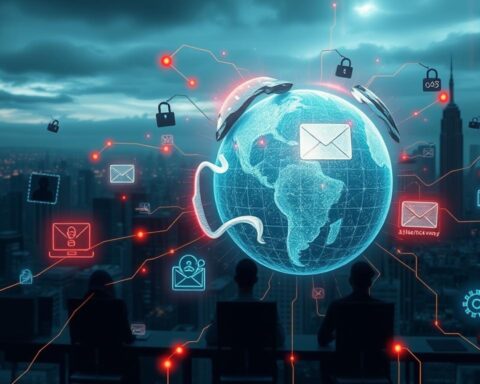Did you know that 30,000 websites get hacked every day1? This shows how important understanding cybersecurity is in our digital world. In our Day 1 Cybersecurity Training, we’ll cover the basics and its impact on our lives and businesses.
Cybersecurity is more than just a term; it’s a digital shield. The cost of cybercrime for businesses has hit $13 million a year2. No business is safe from digital threats. So, knowing the basics of cybersecurity is key for everyone today.
We’ll learn about the main parts of cybersecurity, common threats, and how to protect our digital stuff. This training is for anyone, whether you’re new to tech or experienced. You’ll gain the skills to handle the complex world of cybersecurity.
Cybersecurity isn’t just about tech; it’s about keeping our digital world safe. Human mistakes cause 90% of data breaches2. Your actions are vital in keeping our digital space secure. Let’s explore how we can all help make the internet safer.
Key Takeaways
- Cybersecurity protects digital assets from ever-evolving threats
- The cost of cybercrime is rising, reaching $13 million per organization annually
- Human error causes 90% of data breaches, highlighting the need for awareness
- Cybersecurity is a $200 billion industry, showing its importance
- Knowing basic cybersecurity is vital for everyone in the digital age
- Good cybersecurity needs tech, processes, and human watchfulness
Introduction to Modern Cybersecurity Landscape
The digital world is facing big challenges as cyber threats grow fast. We need strong data protection and network security to keep our information safe. The cybersecurity market is growing fast, expected to reach $345 billion by 2026, up from $217 billion in 20213.
Current State of Digital Security
Today, the digital world is full of risks. Cybercrime costs are going up, expected to hit $10.5 trillion by 2025. This is a 15% yearly increase for the next four years3. Companies are under pressure to improve their online privacy and security.
Growing Importance of Cyber Protection
Cyber protection is more important than ever. Half of data breaches come from phishing and social engineering. Businesses need to focus on training employees and using strong security3. Spending on cybersecurity products and services is expected to exceed $1.75 trillion from 2021 to 20254.
Global Impact of Cybercrime
Cybercrime’s impact worldwide is huge. The cost of a data breach rose to $4.88 million in 2023, a 10% jump. This shows we need better data protection strategies fast4. Companies using AI for security saw a $2.2 million drop in breach costs. This shows the value of new solutions4.
| Cybersecurity Aspect | Statistic | Impact |
|---|---|---|
| Market Growth | $345 billion by 2026 | Increased investment in security solutions |
| Cybercrime Costs | $10.5 trillion annually by 2025 | Urgent need for stronger defenses |
| Data Breach Cost | $4.88 million average in 2023 | Financial pressure on businesses |
| AI-Enabled Security | $2.2 million cost reduction | Potential for significant savings |
What is Cybersecurity and Why It Matters
Cybersecurity is like a shield for our digital world. It keeps our internet-connected devices safe from hackers and cybercriminals. Knowing about cybersecurity is key for both individuals and businesses today.
Cyber threats are serious. They could cost global businesses over $5 trillion in five years5. Small businesses are at high risk, with over 40% facing cyber attacks5.
Not having good protection can lead to big problems. A cyber attack can cost a company about $200,0005. Sadly, 60% of businesses hit by cyber attacks fail within six months5.
“Cybersecurity is not just an IT issue; it’s a business imperative that affects every aspect of an organization.”
Cyber threats are growing fast. By 2023, there will be 43 billion IoT devices, making more targets for hackers5. This growth makes cybersecurity even more critical for keeping data safe and private.
Cyber attacks have had big impacts. In 2012, hackers stole data from over 22 million U.S. government employees6. In 2021, a cyberattack on Colonial Pipeline disrupted oil and gas supplies in the U.S6..
| Year | Cyber Incident | Impact |
|---|---|---|
| 2012-2015 | U.S. Office of Personnel Management Breach | 22 million records compromised |
| 2017 | NotPetya Malware | Worldwide data destruction |
| 2020 | DDoS Attacks on Health Sector | U.S. Health Department and hospitals affected |
| 2021 | Colonial Pipeline Attack | Eastern U.S. oil and gas supply disrupted |
In summary, cybersecurity is about protecting our digital lives. As threats grow, so must our defenses. Understanding cybersecurity is the first step to a safer digital world.
Core Components of Cybersecurity Protection
Cybersecurity is key in today’s digital world. Companies face many threats to their data and networks. They need strong security to protect themselves.
Network Security Elements
Network security is the first defense against cyber threats. It uses hardware and software to keep digital spaces safe. Firewalls, intrusion detection systems, and VPNs work together to protect a network7.
Application Security Basics
Application security keeps software safe from threats. It involves secure coding, updates, and checks for weaknesses. With more cyber attacks, keeping software safe is more important than ever8.
Information Security Framework
An information security framework helps manage security risks. The NIST Cybersecurity Framework is a key guide. It has five main parts: Identify, Protect, Detect, Respond, and Recover7.
Companies using frameworks like NIST CSF see 35% fewer breaches. This shows how important a structured approach to security is79.
Using these core cybersecurity elements is vital for keeping information safe. As threats grow, companies must keep improving their security to stay safe.
Understanding Common Cyber Threats
The digital world is full of cyber threats that can harm both people and businesses. To fight cybercrime, we must first know what dangers exist. Let’s look at some of the biggest cyber threats today.
Malware and Ransomware Attacks
Malware is made to harm and can mess up data and control systems. Ransomware is a type of malware that’s getting worse. In 2021, ransomware attacks went up by 150%, with demands reaching $200,000 on average10. This shows how big of a problem cyber threats are for companies.
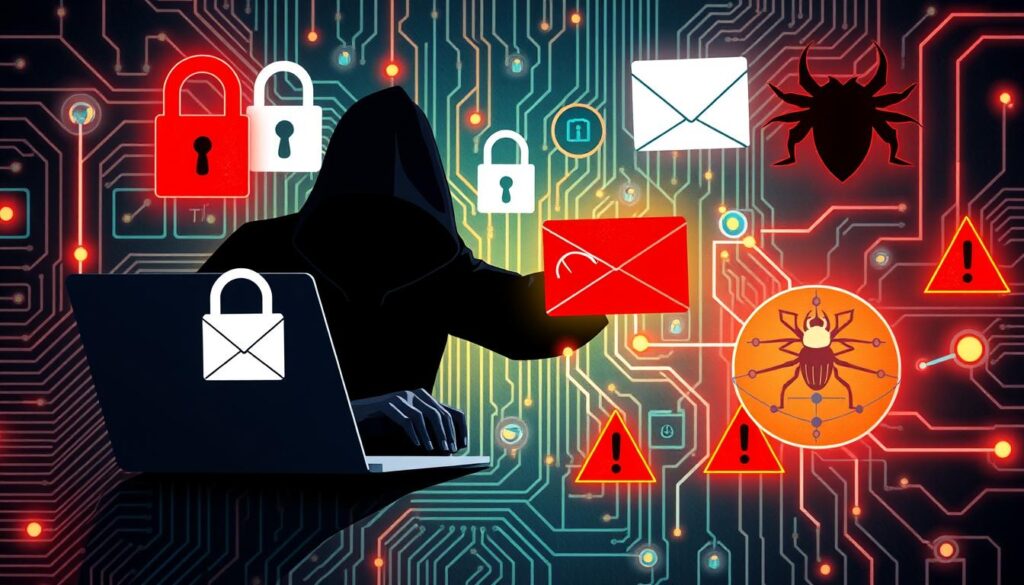
Phishing and Social Engineering
Phishing attacks use tricks to get to your personal info. Over 90% of data breaches start with a phishing email10. During the COVID-19 pandemic, phishing attacks that looked like they were from the virus worked well, using fear and doubt11.
Advanced Persistent Threats
Advanced Persistent Threats (APTs) are long, focused cyber-attacks that go unnoticed for a long time. It takes 207 days on average to find out about a data breach10. These threats use smart tactics and need strong ways to prevent cybercrime.
| Threat Type | Prevalence | Impact |
|---|---|---|
| Ransomware | 150% increase in 2021 | $200,000 average ransom demand |
| Phishing | 90% of successful breaches | Unauthorized access to sensitive data |
| APTs | 207 days average detection time | Long-term system compromise |
Knowing about these common cyber threats is key to stopping cybercrime. By keeping up with the latest info and using strong security, we can protect ourselves and our businesses from digital dangers.
Essential Cybersecurity Technologies and Tools
The world of cybersecurity is changing fast. Spending on cybersecurity products and services is expected to hit over USD 1.75 trillion from 2021 to 202512. This shows how important it is to have strong cybersecurity tools to keep our digital world safe.
Firewalls are key in keeping networks safe. There are three main types: packet filter, connection tracking, and application/layer 713. Packet filter firewalls protect against simple cyberattacks. But application firewalls are more advanced, blocking specific apps like FTP and HTTP13.
Anti-malware software is also vital. It uses three main ways to find threats: behavior-based detection, sandboxing, and signature-based detection13. Next-gen anti-virus software, introduced in 2014, uses machine learning and cloud-based file detonation for better threat detection13.
Penetration testing tools are important for finding system weaknesses. Tools like Kali Linux, Metasploit, and Core Impact help by simulating cyberattacks13. Packet sniffers, such as Wireshark and Tcpdump, are used to watch network traffic and find protocol vulnerabilities13.
| Tool Category | Examples | Primary Function |
|---|---|---|
| Firewalls | Packet filter, Application/layer 7 | Network security, traffic filtering |
| Anti-malware | Next-gen antivirus, Behavior-based detection | Malware prevention and removal |
| Penetration Testing | Kali Linux, Metasploit | Vulnerability assessment |
| Network Monitoring | Wireshark, Tcpdump | Traffic analysis, protocol study |
Companies using AI in security save about USD 2.2 million per breach compared to those without AI12. This highlights the need for advanced cybersecurity technologies to reduce financial risks and improve security.
Data Protection Strategies in Digital Age
In today’s digital world, keeping sensitive info safe is key. Companies face big challenges in protecting data and keeping online privacy strong. The cost of a data breach globally is $3.86 million, with healthcare costs even higher at $7.13 million14. Let’s look at important ways to protect data.
Encryption Methods
Encryption makes data unreadable, keeping it safe from hackers. It uses advanced codes to protect data at rest and in transit. With cyber attacks up 50% in a year, strong encryption is more important than ever14.
Access Control Systems
Strong access controls limit who can see data. They check who you are and what you can do. Companies with good cybersecurity have 27% less downtime from cyber attacks15. Training employees is key, as it cuts cyber attacks by 70%14.
Data Backup Solutions
Having good data backup solutions is vital for recovery. They help keep businesses running if data is lost or stolen. Companies with plans to handle breaches are 2.5 times more likely to stop a breach in 30 days14.
| Strategy | Benefit | Implementation Rate |
|---|---|---|
| Encryption | Secures data at rest and in transit | 85% |
| Access Control | Limits unauthorized data access | 78% |
| Data Backup | Ensures business continuity | 92% |
Using these strategies is critical. 60% of small businesses that get hacked close within six months1415. By focusing on data protection and privacy, companies can lower their risks and build a safer digital future.
Building Strong Security Protocols
In today’s digital world, strong security protocols are key for keeping data safe. Companies must use many steps to guard against new threats.
Teaching employees about cybersecurity is very important. Most data breaches happen because of mistakes by people16. Training in cybersecurity can bring big benefits, showing how important it is to have a culture that values security16.
Using multi-factor authentication (MFA) helps a lot in keeping data safe. It’s also important to keep software up to date to fix security holes17. Companies should update important systems weekly and check access rights every quarter18.
Having a good plan for dealing with cyber attacks is essential. Companies with a plan can save a lot of money on data breaches16. But, 70% of companies don’t have such a plan, making them more vulnerable16.
“Along with this, you should regularly change your password every 60 to 90 days, use multi-factoring authentication and use an antivirus product,” Royster said.
Encryption is a strong tool against cyber attacks, stopping up to 98% of them16. Regular security checks can also help, cutting down on vulnerabilities by up to 28%16. These steps, along with good password policies and data backups, are the core of strong security.
By following these steps, companies can greatly improve their cybersecurity. This helps them fight against the growing danger of cybercrime.
Cybersecurity Best Practices for Organizations
Today, organizations face many cybersecurity threats. It’s vital to have strong cybersecurity practices to keep data safe and stop cybercrimes. Let’s look at some key strategies to boost your organization’s security.
Employee Training Programs
A well-trained team is your first defense against cyber threats. Training programs teach employees how to spot and handle risks. Companies that train their staff well see a 70% drop in human error-related risks19.
Training should cover:
- How to spot phishing attempts
- Best practices for passwords
- Safe browsing habits
- How to handle data
Security Policy Implementation
Make and enforce strong security policies in your organization. These policies should detail how to protect data, control access, and report incidents. Good cybersecurity strategies also include keeping software up to date, as 60% of breaches are due to outdated software19.
Incident Response Planning
Have a solid plan ready for security breaches. This plan should outline how to detect, contain, and manage cyber threats. Companies with good plans can recover 90% of lost data after an attack19.
Key parts of a good plan include:
- Clear roles and responsibilities
- Communication plans
- Steps to contain and remove threats
- Recovery steps
- Post-incident review
By following these cybersecurity best practices, organizations can lower their risk of cybercrimes. Remember, cybersecurity is an ongoing effort that needs constant attention and updates to stay ahead of threats.
| Cybersecurity Measure | Impact |
|---|---|
| Two-factor authentication | Prevents over 98% of unauthorized access attempts |
| Secure file-sharing solutions | 30% less likely to experience data breaches |
| Anti-virus and anti-malware software | Reduces susceptibility to attacks by 45% |
| VPN usage | Up to 70% less risk of data interception |
Using these measures can greatly improve your organization’s cybersecurity19. Stay ahead in fighting cybercrime to protect your assets and keep trust with your stakeholders.
The Role of Cybersecurity Professionals
In today’s digital world, cybersecurity experts are key to protecting companies from new threats. Cybercrime is expected to cost the world $10.5 trillion by 2025. This makes the need for skilled cybersecurity workers very high20.
Key Responsibilities
Cybersecurity pros protect digital stuff and info from bad attacks. They find threats, check risks, and make strong security plans. They also watch networks, handle problems, and follow security rules.
Required Skills and Certifications
To do well in cybersecurity, you need both tech and soft skills. You should know about network security, cryptography, and ethical hacking. Getting certifications like CompTIA Security+, CISSP, and CEH is important in this field.
Career Growth Opportunities
The field of cybersecurity has great job chances. Jobs for info security analysts will grow 31% from 2019 to 2029, much faster than most jobs20. Salaries range from $74,798 for Forensic Computer Analysts to $102,600 for Info Security Analysts, making it a good and well-paid career21.
With more cyber attacks, all kinds of businesses are at risk. A data breach can cost a company over $3.86 million. This shows how important it is to have skilled cybersecurity workers22.
Future Trends in Cybersecurity
The world of cybersecurity is changing fast. New technologies and threats are leading the way. Several important trends are shaping how we protect our digital world.
Artificial intelligence and machine learning are changing the game. AI is used in cybersecurity to spot threats, analyze behavior, and predict vulnerabilities23. This makes the battle between attackers and defenders more complex and dynamic.
Remote work has changed cybersecurity a lot. Workers at home face more cyber threats because of less secure networks24. Now, there’s a big push to keep remote workforces and cloud systems safe.
By 2030, passwords might not be needed anymore. Cybersecurity will be taught in schools25. This shows how important it is to teach people about digital safety and find better ways to log in.
There’s a big problem: not enough cybersecurity experts. Companies need to improve training to prepare for future threats24. This shortage is pushing for more automated security and managed services.
Rules and regulations are also changing cybersecurity. Governments are making stricter laws to improve security in all areas24. Companies handling sensitive data must follow these new rules closely.
To keep up with cyber threats, organizations must stay alert and flexible. The future of cybersecurity will mix advanced tech, skilled people, and strong laws to fight off complex attacks.
Conclusion
Cybersecurity is key in our digital world. Cybersecurity fights a constant battle against IT system complexities and more people online26.
The field of cybersecurity is growing fast, with new jobs opening up. Security analysts can expect a 35% job growth, with salaries from $91,736 to $120,52027. This shows how vital cybersecurity experts are for our digital safety.
Cybercrime is a big problem, with a 400% rise from 2019 to 2020. It costs the world $1 trillion a year28. This highlights the need for strong cybersecurity to protect us all.
It’s important to keep up with cybersecurity tips and new threats. Whether you’re using the internet or working in a company, improving your security is key. Remember, knowing and being careful are our strongest defenses against digital dangers.
FAQ
What is cybersecurity and why is it important?
What are some common cyber threats?
How can individuals protect themselves online?
What are some essential cybersecurity technologies and tools?
How can organizations implement effective cybersecurity measures?
What career opportunities are available in cybersecurity?
What are some future trends in cybersecurity?
Source Links
- What Is Cybersecurity? The Realities of the Digital Age – https://www.apu.apus.edu/area-of-study/information-technology/resources/what-is-cybersecurity-the-realities-of-the-digital-age/
- Why is Cybersecurity Important? | UpGuard – https://www.upguard.com/blog/cybersecurity-important
- Understand the Importance of Cyber Security: Guardian Against Threats! – https://www.simplilearn.com/tutorials/cyber-security-tutorial/what-is-cyber-security
- What Is Cybersecurity? | IBM – https://www.ibm.com/think/topics/cybersecurity
- Why Cybersecurity Matters – https://online.maryville.edu/online-masters-degrees/cyber-security/resources/why-cyber-security-matters/
- Why Is Cybersecurity Important | Cybersecurity | CompTIA – https://www.comptia.org/content/articles/why-is-cybersecurity-important
- NIST Cybersecurity Framework (CSF) Core Explained – https://www.cybersaint.io/blog/nist-cybersecurity-framework-core-explained
- What are the main components of cybersecurity? – https://digitdefence.com/blog/what-are-the-main-components-of-cybersecurity
- Technology Solutions: 5 Essential Components of an Effective Cybersecurity Strategy | Junior Volleyball Association – https://jvavolleyball.org/technology-solutions-5-essential-components-of-an-effective-cybersecurity-strategy/
- Cybersecurity Threats | Types & Sources | Imperva – https://www.imperva.com/learn/application-security/cyber-security-threats/
- What is a Cyber Threat? | UpGuard – https://www.upguard.com/blog/cyber-threat
- What Is Cybersecurity? | IBM – https://www.ibm.com/topics/cybersecurity
- Cyber Security Tools and Techniques | DeVry University – https://www.devry.edu/blog/cyber-security-tools-and-techniques.html
- Cybersecurity in the Digital Age: Ensuring Data Protection and Privacy – https://www.linkedin.com/pulse/cybersecurity-digital-age-ensuring-data-protection-privacy
- What is Cybersecurity? A Comprehensive Guide on Strategies, Technologies, and Best Practices – https://www.digitalguardian.com/blog/what-cybersecurity-comprehensive-guide-strategies-technologies-and-best-practices
- Cybersecurity Protocols – TGG Accounting – https://tgg-accounting.com/cybersecurity-protocols/
- What is cybersecurity? – https://www.cisco.com/site/us/en/learn/topics/security/what-is-cybersecurity.html
- What is Cyber Security? Definition & Best Practices – https://www.itgovernance.co.uk/what-is-cybersecurity
- 21 Cybersecurity Tips and Best Practices for Your Business [Infographic] – TitanFile – https://www.titanfile.com/blog/cyber-security-tips-best-practices/
- Key Roles and Responsibilities of Cyber Security Professionals – https://www.simplilearn.com/it-security-professionals-key-roles-responsibilities-article
- What Do Cybersecurity Professionals Actually Do? | CSU Global – https://csuglobal.edu/blog/what-do-cybersecurity-professionals-do
- The Importance of Cybersecurity Professionals: Protecting Your Business from Cyber Attacks – https://www.linkedin.com/pulse/importance-cybersecurity-professionals-protecting-your-business
- What is the future of cybersecurity? | Field Effect – https://fieldeffect.com/blog/what-is-the-future-of-cyber-security
- Cybersecurity Trends: Looking Over the Horizon to the Future – https://www.apu.apus.edu/area-of-study/information-technology/resources/cybersecurity-trends/
- Seven trends that could shape the “official future” of cybersecurity in 2030 – CLTC – https://cltc.berkeley.edu/publication/seven-trends-cybersecurity-2030/
- Findings and Conclusion – At the Nexus of Cybersecurity and Public Policy – https://www.ncbi.nlm.nih.gov/books/NBK223216/
- What is Cybersecurity and Its Importance to Business | NU – https://www.nu.edu/blog/what-is-cybersecurity/
- What, exactly, is cybersecurity? And why does it matter? – https://www.zdnet.com/education/computers-tech/what-is-cybersecurity-and-why-cybersecurity-matters/
